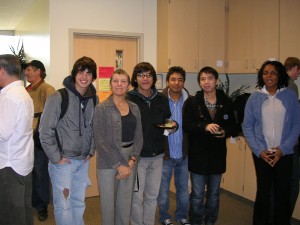Here I am, caught in photos taken at a Philosophy Department party with my Critical Reasoning (PHIL 194) students in the pre-pandemic era. I teach this course regularly together with some other courses in philosophy at all levels — from lower to upper division courses and advanced seminars.
This year I’m having fun teaching Critical Reasoning, Bioethics, and Ethics in Professional Communication entirely online. In Spring 2021 I’ll offer Critical Reasoning again together with a Bioethics course.
For my office hours, email me at snuccetelli@stcloudstate.edu
My Teaching Philosophy
On my view, philosophy is a reflective activity focused on issues that are crucial to a person’s intellectual development. Thus I have, in teaching philosophy, always aimed beyond providing students with encyclopedic information about major philosophical figures and movements or getting them to rehearse some known solutions to the main problems of the discipline. Rather, my goal is to guide student inquiry into some such problems by means of reasoned argument – something I consider constitutive of the very nature of philosophy. Accordingly, critical thinking is central to what I do in the classroom, as well as in my research. Consistent with this view, my first task in designing a course (whether face-to-face, online, or hybrid) is developing tools to elicit students’ participation in answering a set of questions. Once a course is underway, I take my role to be that of guiding the search for philosophical answers. This phase requires helping students build their own critical-thinking competences together with the intellectual virtues necessary for philosophical inquiry such as originality, honesty, inquisitiveness, and open-mindedness. I believe that these learning outcomes can be a great benefit, not only to students of philosophy but to everyone living in a pluralistic, democratic society.
The activities of reading, discussing, and writing amount to essential tools in my understanding of teaching philosophy. I use care in selecting reading assignments so that they are of progressive complexity. I can then reach students of different intellectual abilities, making sure that they understand the principles of charity and faithfulness necessary for fruitful interpretative thinking. I also aim for lively class discussions to promote other skills crucial to philosophy, such as sound argumentation, problem-posing, and problem-solving. Original sources from philosophical and non-philosophical literature usually provide the raw materials to trigger these discussions. Another fundamental element in teaching philosophy is the writing assignment, which should challenge students to produce their own critical assessment of a given philosophical dispute. Accordingly, my preferred paper structure requires students to consider two primary sources on a given philosophical problem, treat one as their target piece and the other as a critical response, and produce their own critical assessment of the dispute — which is the most important part of their papers. Although I’m open to other paper structures, I believe that this one maximizes learning outcomes in a philosophy course.
But a statement of my philosophy of teaching would be incomplete without mention of my provisions for enabling reflection about diversity and inclusiveness. In my experience, there are two strategies available to instructors willing to expose students to these issues, each with advantages of its own. Instructors can either design courses entirely devoted to them or introduce them as part of their regular course offerings. I have experimented with both strategies: the first by developing courses in Multicultural Philosophy, Latin American Philosophy and Latin American Thought and Culture; the second by incorporating issues of diversity and inclusiveness in my courses in some of the standard problems of philosophy. For example, I have prepared assignments about the race and IQ debate in a seminar on rationality, discussed discrimination on the basis of race, disability, age, and gender in a bioethics course, and explained what’s wrong with some informal fallacies such as hasty generalization and ad hominem with illustrations from racist, sexist, and other forms of discrimination.

